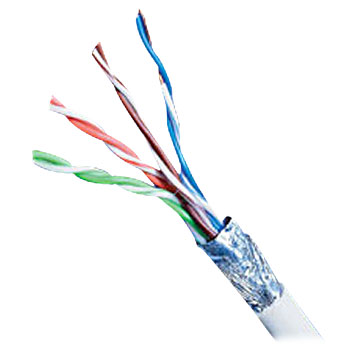Historically, electricity was carried through copper wires insulated first by air (mounted to glass suspension points) and then with cloth on these same glass, ceramic, or wood insulators. Coating wires with rubber or vinyl jackets came later as the manufacturing process improved to what we know it today.

Bell Telephone used glass insulators to suspend wires for early communications but there arose a problem when these long runs came close to other electrical signals. Interference with the telephone signals was introduced by the proximity to these nearby signals producing noise and background distortions.
To improve immunity to such influences, Bell developed a method to change the physical position of the wire so that the left-hand wire would travel on the right and vice versa from one telephone pole to the next.
This physical arrangement greatly improved the immunity of the signal inside these wires from such external influences. Looking at this concept, Bell employed it in creating wire inside the home eventually routing it all the way to the telephone. Called a "twisted pair," this wire had another property unknown at the time: it could also carry more information than wires that were not twisted (greater bandwidth). Today, computer wires that carry signals in the Gigahertz band (billions of cycles per second) use a special variation of this twisted pair concept to do so (called CAT 5e cable).

The point to understand is that non-twisted pair wires can be made into twisted pair wires by merely twisting them together. In doing so, the electrical characteristic of the wire changes and so does the sound.
Most speakers, especially less expensive ones, use two non-twisted conductors between the crossover network and the speaker driver. To improve the bandwidth to the speaker driver, all one must do is to twist the wires that are already there. So, if you have performed speaker tweaks 1A and 1B, you can also twist the wires that go to these drivers thus improving the bandwidth of that wire.
Now some manufacturers use a bonded-pair wire commonly called "zip cord" or "appliance cord" where the two wires are physically connected to each other by the same material that insulates the wire. In this case, these wires are too stiff even when separated and it is not possible to smoothly twist these wires together. But you can REPLACE them with better wires.

Regardless of what you do, twisting or changing the wire inside the speakers changes their sound. Just like changing the wires between your amplifier and your speaker changes the sound, changing the wires inside will do the same.
Yours for higher fidelity,
Philip Rastocny
I do not use ads in this blog to help support my efforts. If you like what you are reading, please remember to reciprocate, My newest title is called Where, oh Where did the Star of Bethlehem Go? It’s an astronomer’s look at what this celestial object may have been, who the "Wise Men" were, and where they came from. Written in an investigative journalism style, it targets one star that has never been considered before and builds a solid case for its candidacy.
- Althea: A Story of Love
- Build an Extreme Green Composter
- The Extreem Green Guide to Wind Turbines
- Build and Extreme Green Hot Water Solar Collector
- The Extreme Green Guide to Solar Electricity
- The Extreme Green Guide to Improving Mileage
- Meditation for Geeks (and other left-brained people)
- Build an Extreme Green Raised Bed Garden
- Build an Extreme Green Rain Barrel
- Build an Extreme Green Squirrel-Proof Bird Feeder
- Extreme Audio 1: House Wiring
- Extreme Audio 2: Line Filtering
- Extreme Audio 3: Chassis Leakage
- Extreme Audio 4: Interconnect Cables
- Extreme Audio 5: Speaker Wires
- Extreme Green Organic Gardening
- Extreme Green Organic Gardening 2012
- The Extreme Green Appliance Buying Guide



No comments:
Post a Comment
To comment on this blog, you must first be a member. All comments are moderated.
Note: Only a member of this blog may post a comment.